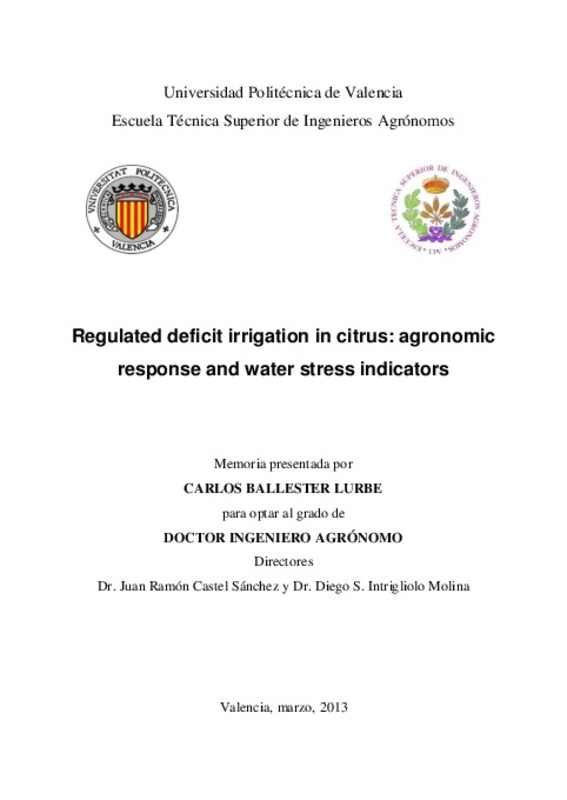- RiuNet repositorio UPV
- :
- Investigación
- :
- Tesis doctorales
- :
- Ver ítem
JavaScript is disabled for your browser. Some features of this site may not work without it.
Buscar en RiuNet
Listar
Mi cuenta
Estadísticas
Ayuda RiuNet
Admin. UPV
Regulated deficit irrigation in citrus: agronomic response and water stress indicators
Mostrar el registro sencillo del ítem
Ficheros en el ítem
| dc.contributor.advisor | Castel Sanchez, Ramon
|
es_ES |
| dc.contributor.advisor | Intrigliolo Molina, Diego Sebastiano
|
es_ES |
| dc.contributor.author | Ballester Lurbe, Carlos
|
es_ES |
| dc.date.accessioned | 2013-05-06T12:47:02Z | |
| dc.date.available | 2013-05-06T12:47:02Z | |
| dc.date.created | 2013-04-17T10:00:19Z | es_ES |
| dc.date.issued | 2013-05-06T12:46:59Z | es_ES |
| dc.identifier.uri | http://hdl.handle.net/10251/28582 | |
| dc.description.abstract | In the Mediterranean area water is a scarce natural resource and periods of drought are frequent. It is then important to increase water use efficiency of irrigated crops. In order to achieve this, one promising option is regulated deficit irrigation (RDI). RDI consists in reducing water application during stages of crop development when yield and fruit quality have low sensitivity to water stress. Full irrigation is provided during the rest of the season to maintain production and fruit quality at adequate levels (Behboudian and Mills, 1997). In citrus, flowering and fruit set are sensitive periods to water restrictions, because water stress during this period increases fruit drop (Ginestar and Castel 1996). The more appropriate phenological period for applying water restrictions seems to be the summer period providing that water applications returned at full dosage sufficiently before harvest in order to allow for compensation in fruit growth (Cohen and Goell 1988). Previous work by González-Altozano and Castel (1999) showed the feasibility of applying RDI in 'Clementina de Nules' and identified threshold values of plant water stress that allowed water savings of about 10-20% without any detrimental effect on yield or fruit size. It would be desirable now to study the extrapolation of these results to commercial orchards of citrus and assess the use of RDI in different citrus cultivars. Two RDI strategies (RDI-1, irrigated at 50% of crop evapotranspiration (ETc) during summer and; RDI-2, irrigated at 35% ETc during the same period to RDI-1) will be compared with a control treatment irrigated at full requirements. As the level of water stress reached by trees is the important factor when RDI strategies are applied, the study of accurate water stress indicators for citrus is also needed. Thus, during the period of water restrictions the use of sap flow and canopy temperature measurements, obtained by thermal imaging or by means of fixed infrared thermometer sensors, will be assessed and compared to classical methods like stem water potential and stomatal conductance. | es_ES |
| dc.language | Inglés | es_ES |
| dc.publisher | Universitat Politècnica de València | es_ES |
| dc.rights | Reserva de todos los derechos | es_ES |
| dc.source | Riunet | es_ES |
| dc.subject | Canopy temperature | es_ES |
| dc.subject | Citrus | es_ES |
| dc.subject | Fruit fresh weight | es_ES |
| dc.subject | Fruit quality | es_ES |
| dc.subject | Regulated deficit irrigation | es_ES |
| dc.subject | Sap flow | es_ES |
| dc.subject | Stem water potential | es_ES |
| dc.subject | Water stress indicators | es_ES |
| dc.subject | Yield | es_ES |
| dc.title | Regulated deficit irrigation in citrus: agronomic response and water stress indicators | |
| dc.type | Tesis doctoral | es_ES |
| dc.identifier.doi | 10.4995/Thesis/10251/28582 | es_ES |
| dc.rights.accessRights | Abierto | es_ES |
| dc.contributor.affiliation | Universitat Politècnica de València. Departamento de Producción Vegetal - Departament de Producció Vegetal | es_ES |
| dc.description.bibliographicCitation | Ballester Lurbe, C. (2013). Regulated deficit irrigation in citrus: agronomic response and water stress indicators [Tesis doctoral]. Universitat Politècnica de València. https://doi.org/10.4995/Thesis/10251/28582 | es_ES |
| dc.description.accrualMethod | TESIS | es_ES |
| dc.type.version | info:eu-repo/semantics/acceptedVersion | es_ES |
| dc.relation.tesis | 4255 | es_ES |
| dc.description.award | Premios Extraordinarios de tesis doctorales | es_ES |
Este ítem aparece en la(s) siguiente(s) colección(ones)
-
Tesis doctorales [5389]







![MS Word file [Word]](/themes/UPV/images/msword.png)

